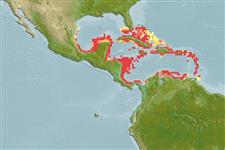Environment: milieu / climate zone / depth range / distribution range
Écologie
marin récifal; profondeur 1 - 50 m (Ref. 115174). Tropical; 26°N - 8°N, 98°W - 60°W
Western Atlantic: Southern Florida and Antilles south to Venezuela.
Taille / Poids / Âge
Maturity: Lm ? range ? - ? cm
Max length : 40.0 cm TL mâle / non sexé; (Ref. 3798); common length : 30.0 cm TL mâle / non sexé; (Ref. 3798)
Épines dorsales (Total) : 12; Rayons mous dorsaux (Total) : 15 - 16; Épines anales: 3; Rayons mous anaux: 8 - 9. Bluish silver with about 18 blackish yellow oblique stripes on body; a small amount of black pigment under upper margin of preopercle.
Occurs in shallow neritic areas, over shallow mud to sand-mud bottoms; less common in areas with clear water and coral reef habitats (Ref. 5217). Marketed fresh and salted (Ref. 3798).
Life cycle and mating behavior
Maturities | Reproduction | Spawnings | Egg(s) | Fecundities | Larves
Oviparous, distinct pairing during breeding (Ref. 205).
Robins, C.R. and G.C. Ray, 1986. A field guide to Atlantic coast fishes of North America. Houghton Mifflin Company, Boston, U.S.A. 354 p. (Ref. 7251)
Statut dans la liste rouge de l'IUCN (Ref. 130435)
Menace pour l'homme
Reports of ciguatera poisoning (Ref. 30303)
Utilisations par l'homme
Pêcheries: commercial; Aquarium: Aquariums publics
Outils
Articles particuliers
Télécharger en XML
Sources Internet
Estimates based on models
Phylogenetic diversity index (Ref.
82804): PD
50 = 0.5000 [Uniqueness, from 0.5 = low to 2.0 = high].
Bayesian length-weight: a=0.01413 (0.00872 - 0.02289), b=2.98 (2.85 - 3.11), in cm total length, based on LWR estimates for this species & Genus-body shape (Ref.
93245).
Niveau trophique (Ref.
69278): 3.5 ±0.5 se; based on diet studies.
Generation time: 6.0 ( na - na) years. Estimated as median ln(3)/K based on 1
growth studies.
Résilience (Ref.
120179): Milieu, temps minimum de doublement de population : 1,4 à 4,4 années (K=0.18).
Fishing Vulnerability (Ref.
59153): Moderate vulnerability (44 of 100).
Nutrients (Ref.
124155): Calcium = 37 [14, 68] mg/100g; Iron = 0.53 [0.28, 0.95] mg/100g; Protein = 19.2 [17.3, 21.0] %; Omega3 = 0.131 [0.071, 0.207] g/100g; Selenium = 31.5 [18.3, 51.6] μg/100g; VitaminA = 94.2 [36.0, 233.6] μg/100g; Zinc = 1.21 [0.84, 1.74] mg/100g (wet weight);
